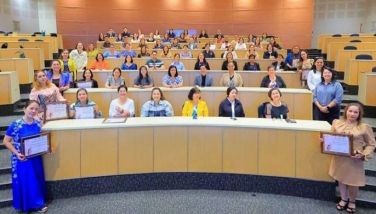Landscapes of hope
June 30, 2001 | 12:00am
 This week I attended the 38th World Congress of the International Federation of Landscape Architects held in Singapore, probably the greenest and cleanest city in the world. This city takes its parks and open spaces seriously. So seriously that its Prime Minister, Mr. Goh Chok Tong, gave the opening address. He articulated his country’s environmental ethos saying the "Cities around the world recognize that economic progress should not be achieved at the expense of the living environment." All cities, that is, except Metropolitan Manila.
This week I attended the 38th World Congress of the International Federation of Landscape Architects held in Singapore, probably the greenest and cleanest city in the world. This city takes its parks and open spaces seriously. So seriously that its Prime Minister, Mr. Goh Chok Tong, gave the opening address. He articulated his country’s environmental ethos saying the "Cities around the world recognize that economic progress should not be achieved at the expense of the living environment." All cities, that is, except Metropolitan Manila.
It was difficult to concentrate on the proceedings at the Singapore International Convention and Exhibition Center, what with the deteriorating socio-political situation in the Philippines and the contrast found in Singapore’s orderly, peaceful, and healthy environment. Our small Philippine delegation made the most of the situation by attending as many of the talks and tours as possible. Three from the group were actual speakers too, giving talks on urban landscape, regional environmental concerns and the state of the landscape architectural profession.
 We did keep in touch though with news from Manila regarding the Mehan. From John Silva of the HCS we found out that the city of Manila may have to put a hold on its plans for building in the Mehan Gardens. Reports John, "Presidential Decree 1151 states specifically that any site deemed an archaeological site by the National Museum will have to undergo an archaeological assessment before any body, in this case the City of Manila, can begin earthmoving activities.
We did keep in touch though with news from Manila regarding the Mehan. From John Silva of the HCS we found out that the city of Manila may have to put a hold on its plans for building in the Mehan Gardens. Reports John, "Presidential Decree 1151 states specifically that any site deemed an archaeological site by the National Museum will have to undergo an archaeological assessment before any body, in this case the City of Manila, can begin earthmoving activities.
"Last week and today, a team from the UP Archaeological Society, led by Ms. Joy Belmonte, along with two National Museum staff members, were able to do surface digging on the site and have found a whole bundle of Ming and Ching Dynasty shards. The discovery gives the museum greater authority to assert Presidential Decree 1151 and will not accede to approving an ECC certification."
It is reported however that the City’s engineering office was able to get an ECC by some means from the DENR. The National Museum was never notified making the authorization unlawful. Another clearance is also needed to allow City Hall to chop down majestic trees in the area. But before this can happen, the DENR has called for a public hearing on the issue.
This is one of the venues where civil society can express their opposition to City Hall’s plans. To remind everyone: the opposition is not on the issue of building a City College (there are other sites and buildings Mayor Atienza could use), but on the issue of loss of public open space, the garden’s treasure of trees and priceless archaeological artefacts. (Everyone can e-mail Secretary Heherson Alvarez at cag_69@hotmail.com to support the HCS, the National Museum and various other NGOs and environmental groups on this matter).
Professor Susan Ong, who is also a member of the Philippine Association of Landscape Architects, presented her research on urban landscapes for "An Innovative Approach in Landscape Design and Planning in Metro Manila." She showed her project to develop a master plan for the landscape development of Roxas Blvd. using endemic Philippine species of Mussaenda (Donas) and Ardisia. It was fascinating to find out that we have not tapped the rich bio-diversity of our own country for plant material we could use for our cityscapes (probably because developers have been prone to hire foreign landscape architects).
Dr. Sanchez gave an engrossing account of the history of landscape architecture in the Philippines and the state of landscape architectural education; practice and the related industry of landscape contracting. He also outlined the UP Los Baños’ plans to establish a degree program in landscape architecture to complement the existing one at the UP Diliman. There is a future for landscape architects in the Philippines. The first keynote speaker, Prof. Favos, had highlighted that the Asian region, in fact, would need several thousand more landscape architects in the next two decades to catch up with the rest of the world. The Philippines, he pointed out, had only one landscape architect for every 600,000 people (compared to the 1:6,000 in developed countries)!
Dr. Perry Ong’s talk was equally fascinating, but from a larger view and context. His paper "Biodiversity Corridors: A Regional Landscape Approach for Conservation in the Philippines" was an eye-opener to the sad state of our natural heritage. Only 18 percent of our total land area have natural forests remaining! Dr. Ong outlined a program that could save what we have left using a regional landscape approach within biophysical parameters and social structures of management. The task is immense, but there are passionate scientists like Dr. Ong leading the almost quixotic fight. Our land and forests do cry out for help.
 Also of interest were topics on sustainable cities, green conservation and myriad other projects and research that made our mouths water  with the fantasy that we could someday use all this knowledge to fix Manila and the rest of the Philippines.
Also of interest were topics on sustainable cities, green conservation and myriad other projects and research that made our mouths water  with the fantasy that we could someday use all this knowledge to fix Manila and the rest of the Philippines.
We just have to start somewhere. And that somewhere is to conserve what we have left. If we cannot implement costly interventions for large scale national and urban parks and conservation areas, then we must keep what little we have left that is still intact… from the 18 percent national forest cover, as well as urban gardens and parks, like the five hectare Mehan Garden.
We must act now. If we lose any- more of our green and cultural heritage, we will have nothing left to pass on to our children but large expanses of concrete and a nation incapable of sustaining anything but politics, terror and hopelessness.
BrandSpace Articles
<
>



















